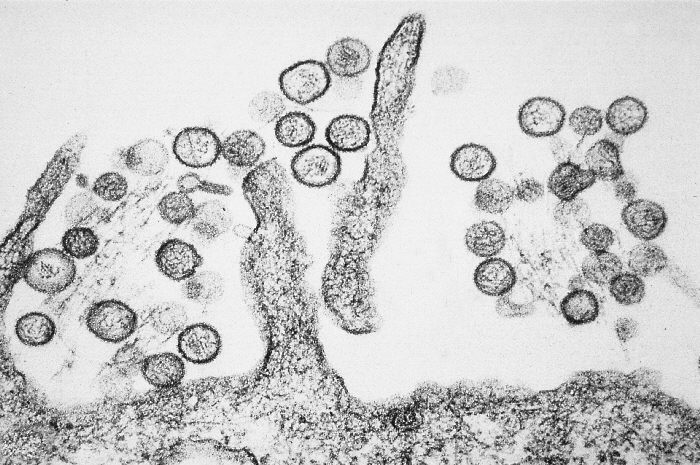Hantavirus: Difference between revisions
| Line 352: | Line 352: | ||
. | . | ||
==Treatment== | ==Treatment== | ||
Revision as of 14:43, 10 August 2015
|
Type chapter name here Microchapters |
|
Diagnosis |
|---|
|
Treatment |
|
Case Studies |
|
Hantavirus On the Web |
|
American Roentgen Ray Society Images of Hantavirus |
| style="background:#Template:Taxobox colour;"|Hantavirus | ||||||
|---|---|---|---|---|---|---|
 Transmission electron micrograph of the Sin Nombre Hantavirus
| ||||||
| style="background:#Template:Taxobox colour;" | Virus classification | ||||||
| ||||||
| Species | ||||||
|
Andes virus (ANDV) |
|
WikiDoc Resources for Hantavirus |
|
Articles |
|---|
|
Most recent articles on Hantavirus |
|
Media |
|
Evidence Based Medicine |
|
Clinical Trials |
|
Ongoing Trials on Hantavirus at Clinical Trials.gov Clinical Trials on Hantavirus at Google
|
|
Guidelines / Policies / Govt |
|
US National Guidelines Clearinghouse on Hantavirus
|
|
Books |
|
News |
|
Commentary |
|
Definitions |
|
Patient Resources / Community |
|
Patient resources on Hantavirus Discussion groups on Hantavirus Patient Handouts on Hantavirus Directions to Hospitals Treating Hantavirus Risk calculators and risk factors for Hantavirus
|
|
Healthcare Provider Resources |
|
Causes & Risk Factors for Hantavirus |
|
Continuing Medical Education (CME) |
|
International |
|
|
|
Business |
|
Experimental / Informatics |
Overview
Hantaviruses belong to the bunyaviridae family of viruses. There are 5 genera within the bunyaviridae family: bunyavirus, phlebovirus, nairovirus, tospovirus, and hantavirus. Each is made up of negative-sensed, single-stranded RNA viruses. All these genera include arthropod-borne viruses, with the exception of hantavirus, which is a genus of rodent-borne agents.
The word hantavirus is derived from the Hantan River, where the Hantaan virus (the etiologic agent of Korean hemorrhagic fever) was first isolated by Dr. Lee Ho-Wang. The disease associated with Hantaan virus is called Korean hemorrhagic fever (a term that is no longer in use) or hemorrhagic fever with renal syndrome (HFRS), a term that is accepted by the World Health Organization.
.
Treatment
- Hanta virus treatment[1]
- Supportive therapy
- ICU management should include careful assessment, monitoring and adjustment of volume status and cardiac function, including inotropic and vasopressor support if needed.
- Fluids should be administered carefully due to the potential for capillary leakage.
- Supplemental oxygen should be administered if patients become hypoxic.
- Equipment and materials for intubation and mechanical ventilation should be readily available since onset of respiratory failure may be precipitous.
- Note (1): There is no specific treatment or cure for hantavirus infection.
- Note (2): Treatment of patients with HPS remains supportive in nature.
- Note (3): Patients should receive appropriate, broad-spectrum antibiotic therapy while awaiting confirmation of a diagnosis of HPS. Care during the initial stages of the disease should include antipyretics and analgesia as needed.
- Note (4): If there is a high degree of suspicion of Hantavirus pulmonary syndrome, patients should be immediately transferred to an emergency department or intensive care unit (ICU) for close monitoring and care.
- Note (5): if the individual is experiencing fever and fatigue and has a history of potential rural rodent exposure, together with shortness of breath, would be strongly suggestive of Hantavirus pulmonary syndrome.
External links
- "Hantaviruses, with emphasis on Four Corners Hantavirus" by Brian Hjelle, M.D., Department of Pathology, School of Medicine, University of New Mexico
- CDC's Hantavirus Information page
- Kruger DH, Ulrich R, Lundkvist A (2001) "Hantavirus infections and their prevention", Microbes And Infection 3 (13): 1129-1144